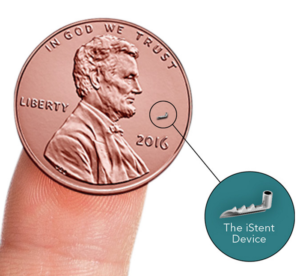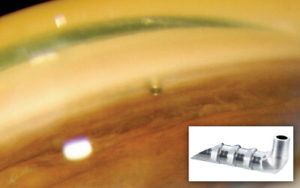MIGS surgeries include a group of intraocular procedures that treat mild to moderate glaucoma and are often done at the same time as cataract surgery. The goal of MIGS is to improve and increase the drainage of fluid from inside the eye, which in effect will lower the intraocular pressure. Traditional glaucoma surgeries require making a fairly large incision into the wall of the eye, and although these surgeries are typically effective in reducing the intraocular pressure, they have many possible complications, including infections. MIGS surgeries on the other hand, utilize microscopic sized drainage devices and very tiny incisions. MIGS are performed inside the eye, making them far less invasive and better maintain the eye’s integrity. MIGS surgeries are also relatively quick and easy to perform by an experienced glaucoma surgeon. Most people who have MIGS performed show a substantial decrease in their eye pressure and can reduce and sometimes eliminate their need for eye drops.
MIGS operations can be divided into the following categories:
- Trabecular bypass
- Microtrabeculectomies
- Suprachoroidal shunts
Trabecular Bypass surgery works by bypassing the trabecular meshwork. This is the structure inside the eye’s natural drainage system that provides most of the resistance to outflow. It is located in the angle of the eye where the iris (the colored structure containing the pupil) meets the sclera (the white wall of the eye). The iStent from Glaukos is a device used in bypass surgery. It is a tiny snorkel like device that is inserted through the trabecular meshwork to bypass it and gain direct access to the collector channels, thereby allowing better drainage.
Microtrabeculectomies utilize the same concept as traditional glaucoma surgeries (trabeculectomies) to form channels connecting the inside of the eye to a space underneath the conjunctiva, the transparent skin of the eye. The major difference being that the channels and the surgery are, once again, created from an internal approach, leaving the eye more intact and less prone to complications. The Xen Gel Stent is a small flexible tube that is inserted from the inside of the eye to this space under the conjunctiva, allowing the surgery to be faster and safer than a traditional trabeculectomy. It was recently approved by the FDA near the end of 2016 and has shown great promise in its early reports.
Suprachoroidal shunts are small tube like devices that are inserted from the inside of the eye. However, they are designed to pass into a deeper area of the eye called the suprachoroidal space. This area is just underneath the scleral wall of the eye and contains a very large number of vascular capillaries. When the shunt is inserted, it allows the fluid in the eye to flow into this rich vascular area where it enters the blood stream and is circulated away from the eye, lowering the pressure.


MIGS may not completely replace the need for drops or traditional glaucoma surgeries, but does fill a major gap in our treatment paradigm for glaucoma, specifically, treating those that require some form of treatment or medication for glaucoma, but are below the threshold for needing more aggressive surgical treatment. Perhaps the best part is that most of the time MIGS surgeries are done at the same time as cataract surgery, so there are no additional trips to the operating room to treat both.





